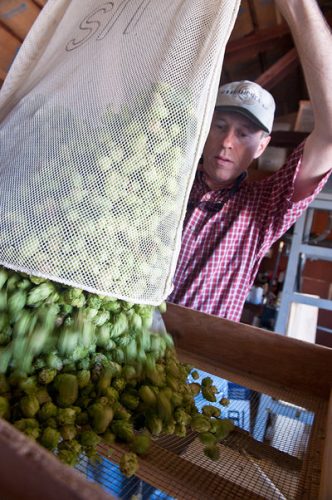
In 1981, when Philomath hops purveyor David Wills first started tinkering with home brewing, “microbrew” was a burgeoning term, and not all that familiar to Oregonian ears.
The hops available to home brewers at that time were “really ugly,” Wills says. “I thought hops were supposed to be brown, and it wasn’t until I visited the USDA Hop Research Farm that I realized hops are actually green.”
Hops are plants with cone-shaped flowers that give beer its bitter, citrusy zing — IPAs are chockfull of them. And they’re kind of a big deal here: Oregon produced 8.2 million pounds of hops from 5,410 acres in 2014, according to the Oregon Hop Commission.
One of the most popular variety of hops, Cascade, was bred in the 1950s at the USDA Hop Research Farm based at Oregon State University, and that program is still going strong in conjunction with OSU’s Hops Breeding Program. The next big hop variety might just come out of Oregon.
“What we’re doing is developing new aroma hop varieties that are acceptable to the craft-brewing industry and adapted to Oregon growing climate conditions,” explains Shaun Townsend, who leads the Hops Breeding Program.
The craft beer industry in Oregon is focused on aroma hops, Townsend says, because those hops play a big role in creating a unique taste or smell. “That’s the palette they paint with,” he says. “What I’m trying to do is give more colors to paint with, trying to broaden the flavors and aromas.”
Wills, who buys hops from growers around the state and sells them to home brewers and home fermenting centers, offers 17 varieties of hops on his Freshops website. Each has its own distinct genetic makeup and flavor profile.
“In ’82, there wasn’t near the varieties that are available now,” Wills says. “There were maybe seven or eight varieties, and it was pretty limited.”
Now, private companies such as the Select Botanicals Group and Hops Breeding Company based in Washington state breed hops that exhibit characteristics appealing to commercial and home brewers alike.
Wills says one of his favorites is the Mosaic hop, a 2012 release that exhibits floral, tropical and earthy characteristics. He also mentions the Simcoe hop, released in 2000 with an “intense pine aroma,” according to his description.
Townsend says results from OSU’s Hops Breeding Program are still five to six years away, but the program has identified a genotype that brewers have enjoyed in test brews. It’s not named yet, but “there’s a lot of excitement about it,” Townsend says. “It grows well in Oregon, so we’re happy about that, and it does well in ales and lagers.”
In the meantime, you can buy one or all of Wills’ 17 varieties of hops at Freshops in Philomath, or visit freshops.com to order online.